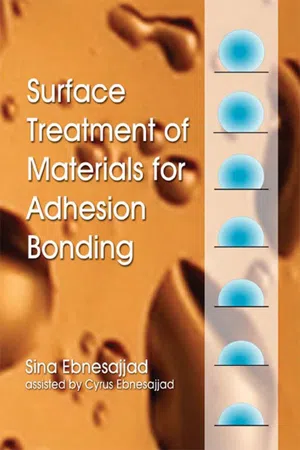1.1 Definition of Surface Preparation, Adhesives, and Adhesive Bonding
Surface preparation or treatment is defined as one or a series of operations including cleaning, removal of loose material, and physical and/or chemical modification of a surface to which an adhesive is applied for the purpose of bonding. In plastics bonding, surface preparation is aimed at increasing the surface polarity, improving surface wettability, and creating sites for adhesive bonding. Metal surfaces are typically covered with oxide layers, rendering the surface highly polar and fit for good adhesive bonding. Surface preparation is intended to enhance the bonding strength to metal surfaces and, primarily, to improve the durability of the bond, especially when exposed to humid environments.
An adhesive is a material applied to surfaces of articles to permanently join them by a bonding process. An adhesive is a substance capable of forming bonds to each of the two or more parts comprising the final object.[1] A feature of adhesives is the relatively small quantities required relative to the weight of the final object.
An entirely satisfactory definition for adhesion has not been found. The following definition has been proposed by Wu.[2] “Adhesion refers to the state in which two dissimilar bodies are held together by intimate interfacial contact such that mechanical force or work can be transferred across the interface. The interfacial forces holding the two phases together may arise from van der Waals forces, chemical bonding, or electrostatic attraction. The mechanical strength of the system is determined not only by the interfacial forces, but also by the mechanical properties of the interfacial zone and the two bulk phases.”
The primary function of adhesives is to join parts together. Adhesives accomplish this goal by transmitting stresses from one member to another in a manner that distributes the stresses much more uniformly than mechanical fasteners. Adhesive bonding often provides structures that are mechanically equivalent to, or stronger than, conventional assemblies at lower cost and weight. In mechanical fastening, the strength of the structure is limited to that of the areas in contact with the fasteners.[3] It is not unusual to obtain adhesive bonds that are stronger than the strength of the adherends (surfaces that are to be bonded together).
1.2 Introduction to Surface Treatment
The main reasons for applying surface treatments prior to bonding are:
1). To remove or prevent the later formation of a weak layer on the surface of the substrate.
2). To maximize the degree of molecular interaction between the adhesive or primer and the substrate surface.
3). To optimize the adhesion forces that develop across the interfaces and therefore insure sufficient joint strength, initially and during the service life of the bond.
4). To create specific surface microstructure on the substrate.
Normally, optimum surface energy and structure is achieved by chemical surface treatment. The chemical composition and the morphology of the surface are altered so that the surface energy of the substrate is maximized for adhesion. Chemical treatments also increase the chances that hydrogen, dipole, van der Waals ionic, and/or covalent bonding can form at the substrate/adhesive interface. A “quick and dirty” test for adequate chemical treatment is to place a bead of water on the surface of the part and note if the water spreads. If so, the contact angle it forms with the surface is very small. There are special fluids called dyne liquids that can fairly precisely bracket the numeric value of the surface energy of a material surface.
Alternative methods to chemical treatment (with similar surface changes) include plasma, corona, and flame treatment methods. These methods act in ways similar to chemical treatments with less hazardous waste generation. Mechanical abrasion is another means of surface preparation. This method is superior to other methods due to the simplicity of the process and significantly less waste generation. Mechanical abrasion works by providing a clean surface and increasing the contact area between the substrate and adhesive. In ordinary gluing of objects, these methods are not needed since optimal adhesion is not always necessary. When a strong adhesion bond is necessary, the minimum required surface preparation is cleaning and removal of dirt and grease from the contact surfaces.
To give the reader an idea of the ba...
